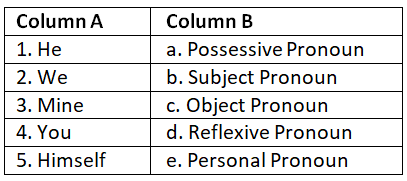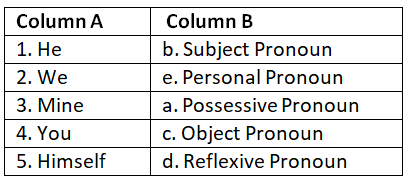Worksheet Solutions: The Pronoun | English Grammar Class 8 PDF Download
| Table of contents |

|
| Section A: Multiple Choice Questions |

|
| Section B: Short Questions |

|
| Section C: Fill in the Blanks |

|
| Section D: Match the Column |

|
| Section E: True or False |

|
Section A: Multiple Choice Questions
Q.1. Which of the following is a pronoun?
(a) Book
(b) Table
(c) He
(d) Running
Ans: (c)
Explanation: A pronoun is a word that takes the place of a noun. "He" is a pronoun as it replaces the noun representing a male person.
Q.2. Select the correct pronoun to complete the sentence: "______ is a good student."
(a) They
(b) Her
(c) It
(d) These
Ans: (a)
Explanation: "They" is the correct pronoun to refer to multiple people, indicating that they are good students.
Q.3. Identify the pronoun in the sentence: "Sheila and I went to the park together."
(a) Sheila
(b) Went
(c) To
(d) I
Ans: (d)
Explanation: In the sentence, "Sheila and I went to the park together," the pronoun "I" refers to the speaker or the person speaking.
Q.4. Choose the pronoun that agrees with the antecedent: "The boys and _____ are going to the movie."
(a) She
(b) They
(c) It
(d) He
Ans: (b)
Explanation: The pronoun "they" agrees with the antecedent "boys" because both refer to more than one person.
Q.5. Which pronoun can replace the underlined phrase in the sentence? "The bicycle that belongs to John is broken."
(a) It
(b) Her
(c) Them
(d) We
Ans: (a)
Explanation: In the sentence, "The bicycle that belongs to John is broken," the pronoun "it" can replace the noun phrase "The bicycle."
Section B: Short Questions
Q.1. Define a pronoun.
Ans: A pronoun is a word that takes the place of a noun in a sentence. It helps avoid repetition and adds variety to sentence structures.
Q.2. Give three examples of personal pronouns.
Ans: Examples of personal pronouns include: I, you, he, she, it, we, they.
Q.3. Rewrite the following sentence, replacing the underlined noun with a pronoun: "My sister loves to sing."
Ans: "She loves to sing." - In this sentence, the noun "sister" is replaced with the pronoun "she."
Q.4. Explain the difference between subject pronouns and object pronouns.
Ans: Subject pronouns are used as the subject of a sentence or clause, while object pronouns are used as the object of a verb or preposition. For example, "I" is a subject pronoun (e.g., I went to the store), and "me" is an object pronoun (e.g., He gave the book to me).
Q.5. Identify the type of pronoun in the sentence: "This is mine."
Ans: The type of pronoun in the sentence "This is mine" is a possessive pronoun. It shows ownership or possession.
Section C: Fill in the Blanks
Q.1. The pronoun "he" is used to refer to _______.
Ans: The pronoun "he" is used to refer to males.
Explanation: The pronoun "he" is used to refer to males, replacing their names or other nouns that represent males.
Q.2. Can you please pass _______ the salt?
Ans: Can you please pass me the salt?
Explanation: The pronoun "me" is used as an object pronoun to refer to the person spoken to.
Q.3. Sarah and _______ are going to the park.
Ans: Sarah and I are going to the park.
Explanation: The pronoun "I" is used as a subject pronoun to refer to the person speaking.
Q.4. They have invited _______ to the party.
Ans: They have invited us to the party.
Explanation: The pronoun "us" is used as an object pronoun to refer to the speaker and one or more other people.
Q.5. The book belongs to _______.
Ans: The book belongs to her.
Explanation: The pronoun "her" is used as a possessive pronoun to show ownership or possession by a female.
Section D: Match the Column
Match the pronouns with their correct types.
Ans:
Section E: True or False
Q.1. A pronoun is a word that takes the place of a noun.
Ans: True
Explanation: A pronoun is a word that is used in place of a noun to avoid repetition.
Q.2. The pronoun "it" can refer to both people and objects.
Ans: True
Explanation: The pronoun "it" can be used to refer to both people and objects depending on the context.
Q.3. "You" is a third-person pronoun.
Ans: False
Explanation: "You" is a second-person pronoun as it refers to the person(s) being spoken to.
Q.4. Reflexive pronouns always come after the verb in a sentence.
Ans: False
Explanation: Reflexive pronouns can come before or after the verb in a sentence, depending on the sentence structure.
Q.5. Possessive pronouns show ownership or possession.
Ans: True
Explanation: Possessive pronouns are used to show ownership or possession, such as "mine," "yours," or "theirs."
|
28 videos|103 docs|37 tests
|

|
Explore Courses for Class 8 exam
|

|













